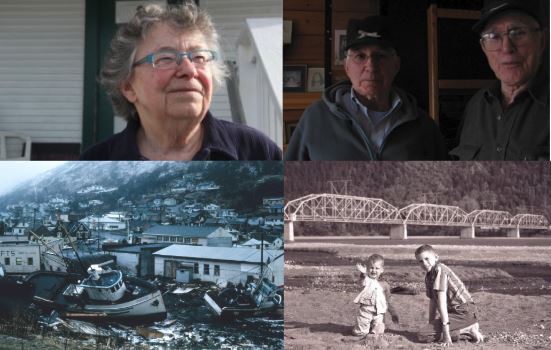
Alaskans of a certain age this week are remembering the Good Friday Earthquake.
55 years ago, on March 27, 1964, a magnitude 9.2 earthquake struck Southcentral Alaska. It remains the largest quake ever recorded in North America, and the second-largest recorded anywhere on Earth.
In 2014, on the fiftieth anniversary of the Great Alaska Quake, KCAW’s Emily Forman prepared a five-part retrospective of the event, featuring residents who experienced it first hand — both in Anchorage and in Southeast.
Here are some excerpts of those remarkable stories.
Dennis Girardot: Those memories of being in the ‘64 earthquake are with me forever, and pretty vivid, even to this day, fifty years later. My mother was in the kitchen preparing a pot of chili and this beautiful birthday cake for my brother in the shape of a guitar. He was a Beatle wannabe at the time. I remember hearing her scream, and the chili went all over the kitchen, all over the cake. The door fell open to the closet and all my brothers presents fell out, so he got to see what he was going to get.
Nancy Davis: Bill, where were we?
Bill Davis: Well, we lived in East Anchorage at that time.
Nancy: What do you remember about that first five-and-a-half minutes?
Bill: Well, as the bookcase started to walk across the floor, that’s when I decided it was time to get out.
Nancy: I don’t know who left first, but I got outside and I held on to the little green VW bug.
Bill: What I remember most is the alders and the cottonwoods across the street: Wild swinging back and forth.
Kent Hanson: On this particular night, instead of taking the shore boat across, we took a 16-foot lapstrake skiff, and we were about halfway to the Langfeld beach, where we were going to beach the boat and walk up. And Warren stood up in the bow and said, “Did you feel that? Did you feel that?!”
Bob Allen: When you reach a point that there’s nothing you can do to take care of your own family, you say okay I’ll take care of what I can with somebody else’s family, and somebody else is going to look after mine, I hope.
Kent Hanson: We were stuck there on the Sitka side, and the shore boat was on the Mt. Edgecumbe side, and they weren’t going to go again until the next morning.
Nancy Davis: It gave me an opportunity to gather an incredible amount of data with the villagers of Old Harbor and Kaguyak, who were relocated — evacuated, really — to Airport Heights School. I met them in Anchorage, and that’s where I recorded the original stories.
Bob Allen: We headed for Old Harbor, because that was wiped out too. And we’re going through hundreds of empty oil barrels, overturned boats, broke-up houses, deep freezes, refrigerators — anything that could float.
Dennis Girardot: I don’t remember being scared. I remember being like, wow, this is maybe even cool.
Bob Allen: That was the worst part of the whole thing for me was coming home and finding my family gone. And all there is is a note on the table from Betty saying that they went to Chiniak. 12 people had drowned on those roads because they got caught in the heads of the bays. I’m panic-stricken.
Emily Forman: 12 frantic hours later Bob finally got a call that his wife and kids had been to Chiniak by plane and were safe.
That was a 2014 retrospective on the 50th anniversary of the Great Alaska Quake, March 27, 1964, from KCAW’s Emily Forman. We heard the voices of Dennis Girardot, Kent Hanson, Nancy and Bill Davis, and Bob Allen.
Note: Emily Forman was KCAW’s Post-Graduate Fellow in Community Journalism in 2013-2014. After her tenure in Sitka, Emily went to WUWM Milwaukee as a producer of the Precious Lives series, and then to WFYI Indianapolis to produce Side Effects. She now works as a podcast producer for Gimlet Media.






























